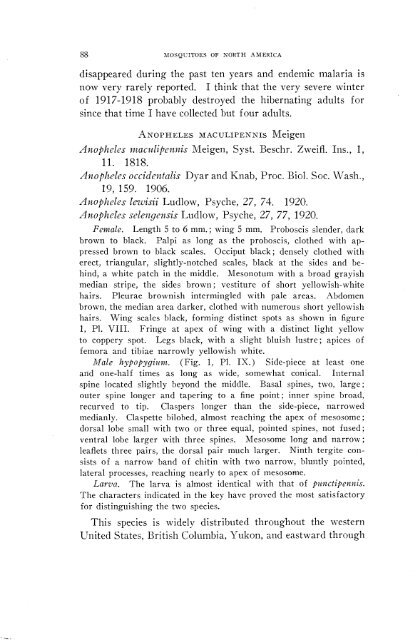a handbook of the mosquitoes of north america - Systematic Catalog ...
a handbook of the mosquitoes of north america - Systematic Catalog ...
a handbook of the mosquitoes of north america - Systematic Catalog ...
You also want an ePaper? Increase the reach of your titles
YUMPU automatically turns print PDFs into web optimized ePapers that Google loves.
88 MOSQUITOES OF NORTH AMERICA<br />
disappeared during <strong>the</strong> past ten years and endemic malaria is<br />
now very rarely reported. I think that <strong>the</strong> very severe winter<br />
<strong>of</strong> 1917-1918 probably destroyed <strong>the</strong> hibernating adults for<br />
since that time I have collected but four adults.<br />
ANOPHELES MACULIPENNIS Meigen<br />
Aaophe1e.s ~ac&ipenni.s Meigen, Syst. Beschr. Zweifl. Ins., 1,<br />
11. 1818.<br />
ANopheles occidentalis Dyar and Knab, Proc. Biol. Sot. Wash.,<br />
19, 159. 1906.<br />
Anopheles lewisii Ludlow, Psyche, 27, 74. 1920.<br />
Anopheles selengensis Ludlow, Psyche, 27, 77, 1920.<br />
Fernale. Length 5 to 6 mm.; wing 5 mm. Proboscis slender, dark<br />
brown to black. Palpi as long as <strong>the</strong> proboscis, clo<strong>the</strong>d with ap-<br />
pressed brown to black scales. Occiput black; densely clo<strong>the</strong>d with<br />
erect, triangular, slightly-notched scales, black at <strong>the</strong> sides and be-<br />
hind, a white patch in <strong>the</strong> middle. Mesonotum with a broad grayish<br />
median stripe, <strong>the</strong> sides brown; vestiture <strong>of</strong> short yellowish-white<br />
hairs. Pleurae brownish intermingled with pale areas. Abdomen<br />
brown, <strong>the</strong> median area darker, clo<strong>the</strong>d with numerous short yellowish<br />
hairs. Wing scales black, forming distinct spots as shown in figure<br />
1, Pl. VIII. Fringe at apex <strong>of</strong> wing with a distinct light yellow<br />
to coppery spot. Legs black, with a slight bluish lustre; apices <strong>of</strong><br />
femora and tibiae narrowly yellowish white.<br />
Male hypopygiuna. (Fig. 1, Pl. IX.) Side-piece at least one<br />
and one-half times as long as wide, somewhat conical. Internal<br />
spine located slightly beyond <strong>the</strong> middle. Basal spines, two, large;<br />
outer spine longer and tapering to a fine point; inner spine broad,<br />
recurved to tip. Claspers longer than <strong>the</strong> side-piece, narrowed<br />
medianly. Claspette bilobed, almost reaching <strong>the</strong> apex <strong>of</strong> mesosome;<br />
dorsal lobe small with two or three equal, pointed spines, not fused;<br />
ventral lobe larger with three spiries. Mesosome long and narrow;<br />
leaflets three pairs, <strong>the</strong> dorsal pair much larger. Ninth tergite con-<br />
sists <strong>of</strong> a narrow band <strong>of</strong> chitin with two narrow, bluntly pointed,<br />
lateral processes, reaching nearly to apex <strong>of</strong> mesosome.<br />
Larva. The larva is almost identical with that <strong>of</strong> pzuzctipemzk.<br />
The characters indicated in <strong>the</strong> key have proved <strong>the</strong> most satisfactory<br />
for distinguishing <strong>the</strong> two species.<br />
This species is widely distributed throughout <strong>the</strong> western<br />
United States, British Columbia, Yukon, and eastward through

















